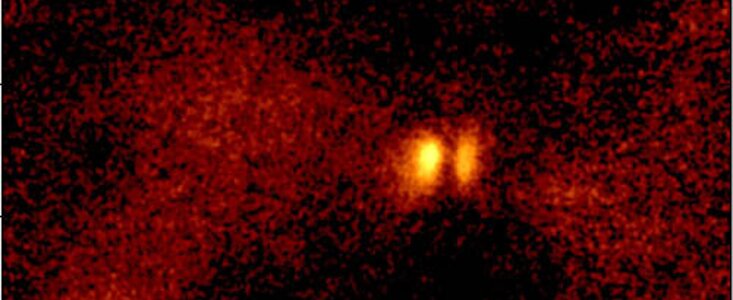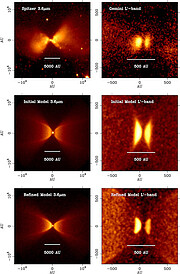A Very Young Circumstellar Disk in Scattered Light
26 Agosto 2010
Recent observations with the Near-Infrared Imager (NIRI) on the Gemini North telescope have revealed the presence of a large circumstellar disk around the young embedded protostar L1527. The discovery team, led by University of Michigan astronomer John Tobin and including Lee Hartmann also of the University of Michigan and Laurent Loinard of the Centro de Radioastronomía y Astrofísica - Universidad Nacional Autonoma de Mexico, detected the disk in scattered mid-infrared light, as shown in geminiann10015a. The upper layers of the disk appear as two bright bowl-shaped features. The mid-plane of the disk hides the central protostar from direct view, resulting in the dark band between the disk surfaces.
The object, located in a star-forming region in the constellation of Taurus, is at a distance of about 450 light-years (140 parsecs) making it one of the nearest and youngest protostars known. Although L1527 is otherwise a fairly typical protostar and will probably result in a star with a final mass about that of the Sun, L1527 is set apart from other young stars with disks because it is very early in the star formation process, even compared to its contemporaries within its host star-forming region. This stage of evolution is called the Class 0 phase, where the protostar is surrounded by a dense infalling envelope composed of gas and dust. The protostar is emitting ultraviolet and visible light, but at this early stage, radiation at these wavelengths remains directly undetectable, being absorbed by the dense envelope and disk and then re-radiated mainly in the far-infrared.
No optical or near-infrared radiation has ever been detected toward the center of the L1527 protostar, but the Spitzer Space Telescope detected a small, faint point of light coming from the center in the mid-infrared (geminiann10015b). The light’s source was unknown because the central protostar was expected to be completely obscured. Tobin’s team hypothesized that there must be some structure that obscures the protostar but bright and compact enough to appear unresolved in the Spitzer Space Telescope images. Tobin et al. constructed a model that resembled a large disk and proposed Gemini observations to test the hypothesis. The initial model is shown in geminiann10015c.
According to Tobin, “We utilized Gemini's unique ability to take images in the mid-infrared from the ground at high resolution. Under natural seeing conditions Gemini was able to give exquisite image quality; the seeing for the observations was 0.3 arcseconds, the equivalent angular size of a penny 8 miles away.”
While Tobin states that the team was “astounded” by how similar their model, based on only the Spitzer images was to the observations, the team refined the model (shown in Figure 3) to better fit the new detailed Gemini images. They found that the disk must be 190 AU in radius or 5 times the size of Pluto's orbit to reproduce the images. This disk size is typical for young stars without envelopes; however, it was expected that L1527 would have a smaller disk because it is at such an early stage of evolution, before the disk has grown. This result implies that disks can grow quite fast, which requires a rapid collapse of the natal cloud. The team also noticed that the disk extends vertically from it equator about twice as far as other disks; this may be due to material from the surrounding envelope falling onto the disk. Finally, the team concludes that these images from Gemini have captured a protoplanetary disk-in-formation around this young star implying that the ingredients for planet formation are already in-place at a very early time in protostellar evolution. The complete work will appear in The Astrophysical Journal Letters and is currently available on astro-ph.




